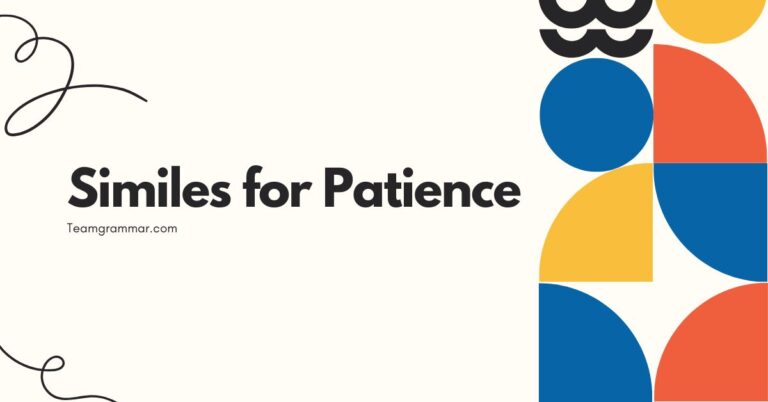43 Similes for Hate: Understanding Figurative Language
Understanding how to express strong emotions like hate through figurative language, specifically similes, is crucial for both effective communication and literary analysis. Similes, by comparing hate to something else, can intensify the feeling and provide a deeper understanding of its nature.
This article explores the various ways similes are used to convey hate, examining their structure, types, and usage rules. This guide will benefit students, writers, and anyone interested in mastering the nuances of English grammar and figurative language.
Table of Contents
- Introduction
- Definition of Simile
- Structural Breakdown of Similes for Hate
- Types of Similes for Hate
- Examples of Similes for Hate
- Usage Rules for Similes
- Common Mistakes When Using Similes
- Practice Exercises
- Advanced Topics in Similes
- Frequently Asked Questions
- Conclusion
Definition of Simile
A simile is a figure of speech that directly compares two different things using the words “like” or “as.” The purpose of a simile is to describe something by associating it with something else that shares a similar quality. Similes are powerful tools for creating vivid imagery, enhancing understanding, and adding emotional depth to writing.
In the context of expressing hate, similes can be particularly effective. They allow writers and speakers to convey the intensity, nature, and impact of hate by comparing it to tangible or relatable concepts.
This comparison can evoke strong emotions in the audience and provide a more nuanced understanding of the speaker’s feelings.
For example, saying “His hate was like a consuming fire” is more evocative than simply stating “He hated.” The simile creates a visual image of destruction and intensity, making the feeling of hate more palpable to the reader or listener. Similes function as a bridge, connecting the abstract emotion of hate to concrete imagery.
Structural Breakdown of Similes for Hate
The basic structure of a simile includes three key components: the subject, the linking word (like or as), and the object of comparison. Understanding these components is essential for constructing effective and meaningful similes.
1. Subject: This is the thing being described, in this case, “hate” or a manifestation of it. It could be a person’s hatred, a feeling of animosity, or the effects of hate.
2. Linking Word: The words “like” or “as” serve as the bridge between the subject and the object of comparison. These words explicitly indicate that a comparison is being made.
3.Object of Comparison:This is the thing to which hate is being compared. The object should share a quality or characteristic with hate that helps to illuminate its nature.
Examples might include a venomous snake, a destructive storm, or a festering wound.
For example, in the simile “His hate was like a venomous snake,” “His hate” is the subject, “like” is the linking word, and “a venomous snake” is the object of comparison. The simile suggests that the hate is dangerous, insidious, and capable of inflicting harm, just like a venomous snake.
The effectiveness of a simile depends on the clarity and relevance of the comparison. The object of comparison should be something that the audience can readily understand and that accurately reflects the intended meaning of the simile.
A well-constructed simile can add depth, nuance, and emotional impact to writing.
Types of Similes for Hate
Similes for hate can be categorized based on the specific qualities or characteristics of hate that they emphasize. Here are several types with examples:
Similes Emphasizing Intensity
These similes focus on the strength or degree of hate, often comparing it to something powerful or overwhelming.
Similes Emphasizing Destructiveness
These similes highlight the damaging or harmful effects of hate, comparing it to things that cause destruction or ruin.
Similes Emphasizing Insidiousness
These similes underscore the subtle, creeping, or hidden nature of hate, comparing it to things that are deceptive or difficult to detect.
Similes Emphasizing Bitterness
These similes focus on the acrimonious or resentful nature of hate, comparing it to things that are sour, unpleasant, or toxic.
Similes Emphasizing Persistence
These similes highlight the enduring or unrelenting nature of hate, comparing it to things that are difficult to eradicate or overcome.
Examples of Similes for Hate
Below are several tables with examples of similes used to describe hate, organized by the categories described above.
Table 1: Similes Emphasizing Intensity
The following table provides examples of similes that emphasize the intensity of hate, showcasing how writers can convey the extreme strength of this emotion through figurative language.
| Simile | Explanation |
|---|---|
| His hate burned like a raging inferno. | This simile suggests that the hate is consuming and uncontrollable, like a fire that is out of control. |
| Her hatred was as potent as a venomous poison. | This compares the hate to a strong poison, indicating its powerful and harmful nature. |
| His anger felt like a volcanic eruption. | This implies that the hate is sudden, explosive, and destructive, similar to a volcano erupting. |
| Their animosity was as fierce as a storm at sea. | This simile conveys the intensity and turbulence of the hate, likening it to a violent storm. |
| His loathing surged like a tidal wave. | The hate is depicted as overwhelming and unstoppable, similar to a massive wave. |
| Her resentment was as sharp as a shard of glass. | This simile highlights the piercing and cutting nature of the hate. |
| His contempt grew like a monstrous weed. | The hate is shown as something that spreads quickly and is difficult to eradicate. |
| Their hatred was as strong as steel. | This comparison suggests that the hate is unyielding and unbreakable. |
| His scorn cut like a knife. | This simile depicts the hate as sharp and painful, capable of inflicting deep wounds. |
| Her bitterness welled up like a geyser. | The hate is shown as something that erupts suddenly and forcefully. |
| His hate resonated like a deafening roar. | This comparison suggests that the hate is overwhelming and impossible to ignore. |
| Her animosity was as cold as ice. | This simile conveys the emotionless and unfeeling nature of the hate. |
| His loathing spread like wildfire. | The hate is shown as something that spreads rapidly and uncontrollably. |
| Their resentment simmered like a pressure cooker. | This implies that the hate is building up and is about to explode. |
| His scorn was as bitter as gall. | This comparison suggests that the hate is extremely unpleasant and distasteful. |
| Her hatred pulsed like a throbbing wound. | This simile suggests a painful and constant presence of hate. |
| His contempt was as unwavering as a mountain. | This comparison highlights the steadfast and unshakeable nature of the hate. |
| Their loathing erupted like a violent storm. | This simile depicts the hate as sudden, explosive, and destructive. |
| Her animosity was as palpable as a physical barrier. | This comparison suggests that the hate is so strong that it feels almost tangible. |
| His resentment festered like a hidden sore. | This simile shows the hate as something that grows worse over time, hidden from view. |
| His hate mounted like a rising tide. | This simile suggests that the hate is gradually increasing in intensity and power. |
Table 2: Similes Emphasizing Destructiveness
This table presents similes that emphasize the destructive nature of hate, illustrating how it can be compared to forces or elements that cause ruin and devastation.
| Simile | Explanation |
|---|---|
| Their hate devoured everything like a swarm of locusts. | This simile suggests that the hate is all-consuming and leaves nothing behind. |
| His animosity was as corrosive as acid. | This compares the hate to a substance that eats away at everything it touches, highlighting its damaging effects. |
| Her scorn ruined lives like a wrecking ball. | This implies that the hate is destructive and causes widespread damage. |
| His hatred spread destruction like a wildfire through a forest. | This simile conveys the rapid and devastating impact of the hate. |
| Their resentment poisoned relationships like toxic waste. | The hate is depicted as something that contaminates and destroys connections between people. |
| His contempt crumbled trust like an earthquake. | This simile highlights the destructive force of the hate, capable of shattering foundations. |
| Her animosity tore families apart like a hurricane. | The hate is shown as a powerful force that causes widespread destruction and division. |
| His loathing eroded their bond like relentless waves. | This comparison suggests that the hate gradually wears away at relationships over time. |
| Their scorn shattered dreams like a hammer on glass. | This simile depicts the hate as a force that destroys hopes and aspirations. |
| His hatred decimated their community like a plague. | This implies that the hate is widespread and causes significant harm to a large group of people. |
| Her resentment festered like a gangrenous limb. | This simile suggests that the hate is decaying and causing further damage. |
| His contempt withered their spirits like a drought. | This comparison shows the hate as something that drains vitality and hope. |
| Their animosity consumed their souls like a black hole. | The hate is depicted as an insatiable force that absorbs everything. |
| His loathing destroyed happiness like a bomb. | This simile highlights the sudden and devastating impact of the hate. |
| Her hatred contaminated everything like radiation. | This comparison suggests that the hate is pervasive and leaves a lasting negative impact. |
| His scorn ravaged the land like a conquering army. | This simile depicts the hate as a force that pillages and destroys everything in its path. |
| Their resentment ruined their lives like a financial crisis. | This comparison suggests that the hate can have far-reaching and devastating consequences. |
| His hatred extinguished hope like a snuffing a candle. | This simile depicts a quick and total elimination of hope. |
| Her scorn divided the nation like a deep chasm. | This comparison shows the hate as something that creates significant separation and division. |
| His contempt poisoned his mind like a deadly neurotoxin. | This simile suggests that the hate is harmful and affects his thoughts and perceptions. |
| Their animosity wrecked their ambitions like a shipwreck. | This comparison shows the hate as something that destroys plans and aspirations. |
Table 3: Similes Emphasizing Insidiousness
This table presents similes emphasizing the insidious nature of hate, showing how it can be subtle, deceptive, and difficult to detect, often compared to hidden or creeping elements.
| Simile | Explanation |
|---|---|
| His hate crept into their hearts like a silent disease. | This simile suggests that the hate is subtle and spreads unnoticed. |
| Her animosity was as subtle as a snake in the grass. | This compares the hate to something hidden and dangerous, implying treachery. |
| His scorn festered beneath the surface like a hidden wound. | This implies that the hate is growing worse over time, concealed from view. |
| Their hatred spread stealthily like a creeping vine. | This simile conveys the gradual and unnoticed growth of the hate. |
| His resentment grew invisibly like mold in the dark. | The hate is depicted as something that thrives in secrecy and is difficult to detect. |
| Her contempt lurked in her eyes like a predator waiting to strike. | This simile highlights the hidden and threatening nature of the hate. |
| Their animosity simmered quietly like a dormant volcano. | The hate is shown as something that is present but not immediately apparent, with the potential to erupt. |
| His loathing infiltrated their lives like a subtle poison. | This comparison suggests that the hate is gradually corrupting everything it touches. |
| Her scorn hid behind a smile like a wolf in sheep’s clothing. | This simile depicts the hate as deceptive and untrustworthy. |
| His hatred festered in his mind like a malignant tumor. | This implies that the hate is growing uncontrollably and causing harm. |
| Their resentment spread covertly like a secret conspiracy. | This simile suggests that the hate is being spread in a hidden and organized manner. |
| His contempt dripped from his words like slow-acting venom. | This comparison shows the hate as something that is gradually harmful. |
| Her animosity shadowed their every move like a persistent stalker. | This simile depicts the hate as something that is constantly present and threatening. |
| His loathing disguised itself like a chameleon. | This implies that the hate is adapting to its surroundings to remain undetected. |
| Her hatred worked its way into his mind like subliminal messaging. | This comparison suggests that the hate is influential and insidious. |
| His scorn spread under the guise of concern like a Trojan horse. | This simile depicts the hate as something deceptive and dangerous. |
| Their resentment took root in their minds like an invasive species. | This comparison suggests that the hate is difficult to eradicate. |
| His hatred manifested in subtle actions like microaggressions. | This simile depicts how hate can be expressed in small, often unintentional ways. |
| Her scorn seeped into the culture like a slowly spreading contaminant. | This comparison shows the hate as something that gradually corrupts the environment. |
| His contempt grew in secret like a clandestine operation. | This simile suggests that the hate is being nurtured in a hidden and organized manner. |
| Their animosity was a silent killer like carbon monoxide. | This comparison shows the hate as deadly and undetectable. |
Usage Rules for Similes
Using similes effectively requires attention to several rules. The most important rule is that the comparison must be logical and understandable.
The shared characteristic between the subject and the object of comparison should be clear to the audience.
1. Clarity: The simile should be easy to understand. Avoid obscure or overly complex comparisons that may confuse the reader or listener.
2. Relevance: The object of comparison should be relevant to the subject. The shared characteristic should be significant and contribute to the overall meaning of the simile.
3. Originality: While common similes can be effective, strive for originality to make your writing more engaging and memorable. Avoid clichés whenever possible.
4. Context: Consider the context in which the simile is being used. The simile should be appropriate for the tone, style, and audience of the writing or speech.
5. Avoid Mixed Metaphors: Ensure that the simile does not create a mixed metaphor, where the comparison becomes illogical or contradictory.
For example, the simile “His hate was like a raging fire” is clear, relevant, and appropriate in many contexts. However, the simile “His hate was like a raging fire but also as cold as ice” creates a mixed metaphor because fire and ice are contradictory.
Common Mistakes When Using Similes
Several common mistakes can undermine the effectiveness of similes. Being aware of these mistakes can help you avoid them in your own writing.
1. Using Clichés: Overused similes, such as “as red as a rose” or “like a fish out of water,” can make your writing seem unoriginal and predictable.
2. Creating Mixed Metaphors: Combining incompatible images can create confusion and undermine the clarity of your writing.
3. Making Illogical Comparisons: The comparison should be logical and based on a clear shared characteristic between the subject and the object of comparison.
4. Overusing Similes: Too many similes can make your writing seem cluttered and distracting. Use them sparingly and only when they add significant value.
Here are some examples of common mistakes and how to correct them:
| Incorrect Simile | Corrected Simile | Explanation |
|---|---|---|
| His hate was like a fish out of water. | His hate was like a suffocating blanket. | The corrected simile provides a more original and relevant comparison to the feeling of hate. |
| His hate was like a raging fire but also as still as a pond. | His hate was like a raging fire. | The corrected simile removes the mixed metaphor and maintains a clear image. |
| His hate was like a car. | His hate was like a runaway train. | The corrected simile provides a more logical and relevant comparison, highlighting the unstoppable nature of the hate. |
Practice Exercises
Test your understanding of similes with the following exercises. For each sentence, fill in the blank with an appropriate simile that expresses hate.
Exercise 1
Complete the following sentences with similes that express hate. Think about the intensity, destructiveness, insidiousness, bitterness, or persistence of hate when choosing your comparison.
| Question | Answer |
|---|---|
| 1. His hate burned __________ . | His hate burned like a scorching sun. |
| 2. Her animosity was as corrosive __________ . | Her animosity was as corrosive as battery acid. |
| 3. Their scorn spread __________ . | Their scorn spread like a poisonous rumor. |
| 4. His hatred festered __________ . | His hatred festered like a deep, unhealed wound. |
| 5. Her resentment grew __________ . | Her resentment grew like a monstrous, thorny vine. |
| 6. Their contempt was as bitter __________ . | Their contempt was as bitter as a cup of unsweetened black coffee. |
| 7. His loathing consumed him __________ . | His loathing consumed him like a relentless disease. |
| 8. Her scorn cut __________ . | Her scorn cut like a newly sharpened knife. |
| 9. Their hatred echoed __________ . | Their hatred echoed like a haunting scream in the night. |
| 10. His animosity lingered __________ . | His animosity lingered like a dark, ominous shadow. |
Exercise 2
Rewrite the following sentences using similes to express the feeling of hate more vividly.
| Original Sentence | Rewritten Sentence with Simile |
|---|---|
| 1. He hated her. | He hated her like a venomous snake hates its prey. |
| 2. Her anger was strong. | Her anger was as strong as a raging hurricane. |
| 3. They felt animosity towards each other. | They felt animosity towards each other like two warring nations. |
| 4. His contempt was obvious. | His contempt was obvious, shining like a malevolent beacon. |
| 5. Her resentment was always there. | Her resentment was always there, lurking like a shadow in the corner of a room. |
| 6. His scorn was very hurtful. | His scorn cut deeply, like shards of glass in the soul. |
| 7. Their hatred destroyed their relationship. | Their hatred destroyed their relationship like a wildfire consumes a forest. |
| 8. Her loathing was intense. | Her loathing was intense, burning like the fires of hell. |
| 9. His contempt was unwavering. | His contempt was unwavering, standing firm like an impenetrable fortress. |
| 10. Their animosity poisoned everything. | Their animosity poisoned everything like a slow-acting venom. |
Advanced Topics in Similes
For advanced learners, exploring the nuances of similes can lead to a deeper appreciation of their power and complexity. This includes understanding how similes interact with other figures of speech, such as metaphors and personification, and how they can be used to create complex layers of meaning.
One advanced technique is the use of extended similes, where the comparison is developed over several sentences or even paragraphs. This allows for a more detailed and nuanced exploration of the shared characteristics between the subject and the object of comparison.
Another advanced topic is the use of irony in similes. This involves using a simile to express the opposite of what is literally stated.
For example, saying “His hate waslikea warm embrace” can be an ironic way of conveying the cold and destructive nature of the hate.
Additionally, understanding the cultural and historical context of similes can enhance their effectiveness. Some comparisons may have different meanings or connotations in different cultures or time periods.
Frequently Asked Questions
Here are some frequently asked questions about similes and their usage:
- What is the difference between a simile and a metaphor?
A simile compares two things using “like” or “as,” while a metaphor directly equates them. For example, “His hate was like a fire” is a simile, while “His hate was a fire” is a metaphor.
- Can a simile be too obvious?
Yes, overused or cliché similes can make your writing seem unoriginal. Strive for fresh and creative comparisons.
- How can I make my similes more effective?
Choose comparisons that are clear, relevant, and original. Consider the context and audience, and avoid mixed metaphors.
- Is it okay to use similes in formal writing?
Yes, similes can be used in formal writing, but use them judiciously and ensure they are appropriate for the tone and style of the piece.
- What is a mixed metaphor, and how can I avoid it?
A mixed metaphor combines incompatible images, creating confusion. To avoid it, ensure that all parts of your comparison are logically consistent.
- How do I choose the right object of comparison for my simile?
Select an object that shares a significant characteristic with the subject and that will resonate with your audience.
- Can I use similes to describe abstract concepts?
Yes, similes are often used to make abstract concepts more concrete and understandable by comparing them to tangible things.
- How can I use similes to create a specific mood or tone?
Choose comparisons that evoke the desired emotions or associations. For example, comparing hate to a venomous snake creates a mood of fear and danger.
- Are there any cultural considerations when using similes?
Yes, some comparisons may have different meanings or connotations in different cultures. Be mindful of your audience and choose comparisons that will be understood and appreciated.
- What is an extended simile?
An extended simile is a comparison that is developed over several sentences or paragraphs, allowing for a more detailed exploration of the shared characteristics between the subject and the object of comparison.
- How can I use similes to make my writing more descriptive?
By choosing vivid and evocative comparisons, you can create strong mental images in the minds of your readers, making your writing more engaging and memorable.
- Should I always avoid clichés in my similes?
While it’s generally best to avoid clichés, they can be effective in certain contexts, especially if used ironically or with a twist. However, strive for originality whenever possible.
Conclusion
Mastering similes is essential for enhancing your writing and communication skills. By understanding their structure, types, and usage rules, you can effectively convey complex emotions like hate and create vivid imagery for your audience.
Remember to focus on clarity, relevance, and originality when crafting your similes.
Practice using similes in your writing and speaking, and pay attention to how other writers use them. With time and effort, you can develop a strong command of this powerful figure of speech.
By avoiding common mistakes and continually refining your skills, you’ll be able to elevate your writing and express yourself with greater precision and impact.







